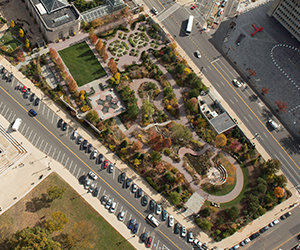 Why Sustainable Practices?
Why Sustainable Practices?
At the U.S. Botanic Garden, we live what we preach. And, like our visitors, we know that living sustainably is a process. We are continually learning and expanding our conservation and sustainability practices.
Paving, pollution, erosion and other consequences of human actions have reduced our planet’s ability to support living organisms, ourselves included. Agriculture and technology cannot indefinitely offset these losses, and we cannot replace lost biodiversity.
Since we are shaping the destiny of future generations, it is time to do it wisely. We invite you to learn more about sustainability efforts here at the U.S. Botanic Garden, and encourage you to consider ways you can embrace similar practices:
Compost
Compost is a natural mulch and soil amendment produced from landscape and household organic material, reducing waste going to landfills. Compost improves soil structure, texture and fertility, increases the soil’s ability to hold both water and air and stimulates healthy root development in plants. Where will you put your own compost pile?
Rainscaping
Rainscaping can be a beautiful solution to water pollution. Rain gardens are landscape features that capture storm water in a shallow depression, allowing the water to slow down, spread out and soak into the ground, rather than be channeled into a storm sewer and ultimately nearby waterways. Rain barrels, which collect rainwater from rooftops, are effective for conserving water. How can you conserve water?
Roses Can Be Green
To earn a place in our organic Rose Garden devoted to the national flower, each rose must perform without applications of fungicides and pesticides. Each year, our gardeners evaluate these roses and replace those that do not perform well in our hot, humid client. What chemicals can you live without?
Native Plants
Discover the diversity and ornamental beauty of our native trees, shrubs and herbaceous plants! Native plants save water, maintenance costs and provide appropriate habitat for pollinators. In the Regional Garden in our gated outdoor gardens, you will find plants native to the Mid-Atlantic region. What native plants are in your garden?
Plant Pollinators
By creating a pollinator-friendly habitat in your own garden, you can ensure that plant pollinators have the food, water and shelter needed to survive and perform their important ecological roles. Pollinators are the basis of the reproductive cycle of plants and are crucial to the food we eat. Are you pollinator friendly?